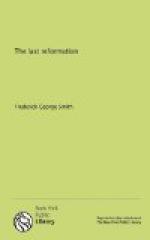The general description of the two-horned beast, however, makes prominent an evil characteristic—the disposition to lead the people into deception by making an image to the beast and then worshiping it. The evil is not located in the ability to bring down fire from heaven, but in the deceptive work of image-making and image-worship, for which the spiritual work simply furnished an occasion. The spiritual work of reformation is, therefore, to be distinguished from the later work of creed-and sect-making; and since the beast takes advantage of the manifestation of spiritual power and deceives men, he becomes a sort of apostate and is denominated “the false prophet” (see chap. 16:13; 19:20).
The beast, ecclesiastically considered, stands as the symbol of the religious system and practise of Protestantism as a whole—a peculiar combination of truth and error, of good and bad, of “fire from heaven” and false miracle-working power (chap. 16:14); while the “image to the beast” signifies the sectarian institution—the man-made and man-controlled unscriptural sect machinery constructed in imitation of the papal original. To construct such earth-born churches and lead people to adore and worship them is but a species of idolatry and the rankest deception. It is a sad fact, in Protestantism as well as in Catholicism, that vast multitudes of people are more devoted to their respective churches than to the Lord Jesus Christ. They can witness the open rejection of God’s precious Word and the vilest profanation of his holy name without uttering a word of protest; but let any one say a word against their church, and instantly they are aroused to the highest pitch of indignation. Beast-worshipers!
The Protestant era has witnessed many wonderful reformations in which the true fire of God fell upon waiting souls, but this initial work of the Spirit has in each instance been employed as an excuse for taking the next step—making an image; and thousands of honest souls, lacking better light, have been induced to submit to such human organization. Those of this number who were truly saved, however, always loved and adored their Lord more than the human church to which they were attached, and consequently they should not be regarded as beast-worshipers. They are the ones whom the Lord denominates his people when the voice calls them out of Babylon (chap. 18:4).




